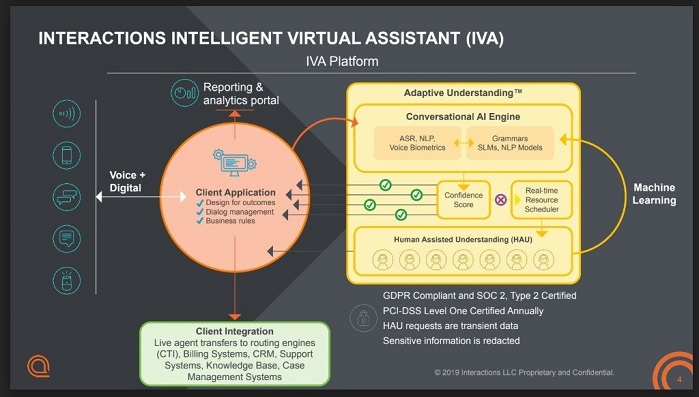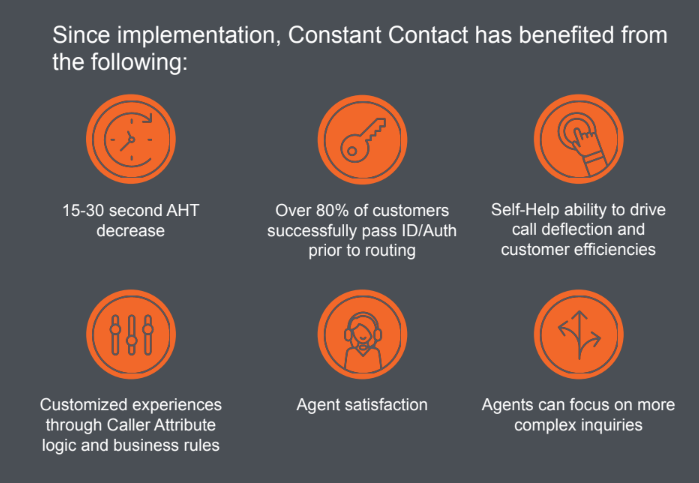Conversational AI at Constant Contact Call Centers: ‘Not a Science Experiment’

If misery in modern life happens to be your field of interest, go visit a call center. In the cubicles, row on row, we observe underpaid, tedium-addled customer service agents processing a funereal procession of repetitive tasks while, very likely, daydreaming about doing something else for work; in the hot, noisy computer room we see stressed-out IT staffers wrestling with non-intuitive, un-integrated and generally inadequate technologies; on the phone we find infuriated customers running the gauntlet of IVR systems that never ask the right question (“Please listen carefully to the following options as our menu has changed….”); and there's the harried call center manager struggling to hire more workers, to mollify the IT manager demanding a tech upgrade, to placate over-promised clients complaining about bad customer experiences.
Do we paint too bleak a picture? Perhaps. But a measure of industry misery is found in the high turnover rate of the nearly 3 million American call center employees who work in 6,800 U.S. call centers (and at home): 35 to 40 percent quit each year, more than double the turnover of other industries in the U.S.
Can anything be done?
![]() Constant Contact is trying. The “integrated marketing” company that made its name with its email marketing platform has hundreds of thousands of customers, most of them small businesses that frequently need help ranging from technical assistance to billing. Faced with the common catalog of call center challenges, the company about three years ago began introducing conversational AI from Massachusetts-based Interactions into its customer support capabilities.
Constant Contact is trying. The “integrated marketing” company that made its name with its email marketing platform has hundreds of thousands of customers, most of them small businesses that frequently need help ranging from technical assistance to billing. Faced with the common catalog of call center challenges, the company about three years ago began introducing conversational AI from Massachusetts-based Interactions into its customer support capabilities.
Speaking at the recent AI World conference in Boston, Ben Bauks, a senior business systems analyst at Constant Contact, said the company was compelled to try AI-based customer support because of growing call volumes coming in on the company's 70 customer service phone lines combined with a shortage (and high turnover) of call center workers. The company was also dogged by operational and customer experience shortcomings: high internal call transfer rates due to not knowing who customers were or why they were likely to be calling resulting in customers routed from agent to agent, then left on hold. In addition, the limitations of the old IVR (interactive voice response) system prevented customized call flows.
“I think we’ve all gotten frustrated one way or another when you call in and you get an IVR menu and none of the options are relevant to what your question is,” Bauks said, adding that small business managers don’t enjoy this any more than do consumers – possibly less, “so you press zero and then you get into a general queue and you’re just in this non-stop loop trying to get your questions answered… There was poor efficiency, something we really wanted to solve, especially when catering to small businesses.”
Three years ago, Constant Contact began PoC project work with Interactions, a $100 million company with more than 550 employees based in Franklin, MA, whose customers include MetLife, Hyatt Hotels and Shutterfly. Speaking alongside Bauks at AI World, Interactions CMO Jim Freeze said the number one use case for AI is customer service (see “Geico Walks with Watson on AI Journey”) and that a key distinction between chatbots and conversational AI is integration of the latter with companies’ backend CRM systems and data, enabling real-time access to customers’ business and usage information, prior reasons they sought support, billing and payment history, and so forth.
“At the same time the organization is responsible for the customer experience,” Freeze said, “they also are under pressure to cut costs. …AI allows you to solve those problems simultaneously. There’s an ongoing imperative for digital transformation, and we’re at the center of it. Three or four years ago, AI at many companies was still viewed as a science experiment. Not any more. We’re doing it at scale. And in customer service, we believe we’re at the beginning phases of early adopters moving to mainstream deployments.”
Freeze said Interactions builds a custom IVA (intelligent virtual assistant) for each client, hosted in Interactions’ cloud infrastructure – custom, he said, in that “it has the personality of the brand of that (client) company, it follows the business rules of whoever that customer is, and it’s designed to facilitate the outcomes that the customers of our customers want – so it’s a bespoke build.”
 Interactions’ proprietary IVA tech stack is a combination of natural language processing, natural language generation, dialogue management techniques and automated speech recognition (ASR) that the company calls “adaptive understanding.” Freeze said Interactions delivers a sophisticated capability that people can converse with freely – while also keeping a human in the loop to help the system when customers can't be understood. This results in conversational adaptivity, rather than rules-based IVR.
Interactions’ proprietary IVA tech stack is a combination of natural language processing, natural language generation, dialogue management techniques and automated speech recognition (ASR) that the company calls “adaptive understanding.” Freeze said Interactions delivers a sophisticated capability that people can converse with freely – while also keeping a human in the loop to help the system when customers can't be understood. This results in conversational adaptivity, rather than rules-based IVR.
Here’s how an Interaction near-time call flow proceeds. When customers call an Interactions client they don’t hear: “You have reached customer support, please listen carefully to the following….” Instead, they hear: “How may I help you?” In conversational AI circles, what the customer says next is called an “utterance.”
“Our system can understand complete sentences…,” Freeze said, “So somebody says something and it comes into our system …, it can be a single word or a 45 second diatribe from someone who’s angry about something. That utterance comes into our system, our own ASR is very sophisticated, it takes speech and turns it into text, and then an NLP engine takes that text and tries to extract meaning from it: What’s the intent of that caller?”
The system analyses the call and gives its results a confidence score. If the system has high confidence it understands customer intent, it sends instructions to the IVA telling it to execute a response based on the client’s business rules – which could be anything from dipping into the customer’s data and providing billing information to answering a licensing question.
More interesting, Freeze said, is when the confidence score is low.
“Sometimes we’re not quite sure what the customer said or wants because there’s loud background noise, or a heavy accent, or slurring or a bad connection,” he said. In these cases the call is routed in real time to what Interactions calls an "intent analyst," a professional listener who determines intent and sends a message to the IVA, which executes the business rule. Whenever an intent analyst is involved in a call, the utterance is tagged and fed into the system’s machine learning loop to improve the data model used for the client’s IVA.
The process happens quickly, Freeze said, and in compliance with PCI-Level 1 security requirements and with GDPR and other data protection regulations.
Bauks said Interactions has driven down Constant Contact costs and improved customer support.
Handle time – the amount of time agents spend on calls – have been cut on average by between 15 and 30 seconds. “When you look at that number it doesn’t seem mind blowing,” Bauks said, “but when you look at cost per call and you analyze the numbers, you realize there’s an FTE head count savings.”
 Another positive measure: customer identification and authentication is now achieved 80 percent of the time. Using conventional phone systems, customers typically must answer a series of questions asked by the IVR (account number, last four Social Security numbers, etc.) before accessing an agent – who then asks the same questions. But Bauks said the Interactions system is synched up with its CRM system (Salesforce), so that answers to ID/authentication questions are asked once, and verified, by the Interactions’ IVA.
Another positive measure: customer identification and authentication is now achieved 80 percent of the time. Using conventional phone systems, customers typically must answer a series of questions asked by the IVR (account number, last four Social Security numbers, etc.) before accessing an agent – who then asks the same questions. But Bauks said the Interactions system is synched up with its CRM system (Salesforce), so that answers to ID/authentication questions are asked once, and verified, by the Interactions’ IVA.
And Constant Contact can better handle customer calls.
“We wanted to personalize the experience for our customer base…,” Bauks said, “we wanted to be able to I.D. the customer through different attributes because attributes tend to dictate where we route the customer…. For example, if a customer is a trialer, they’re just starting their customer journey with us, we might want them to speak with a skill agent with a dedicated skill set that really caters to that trialer experience – because the whole point is to convert the trialer into a paying customer.”
Part of caller authentication is what Bauks called “risk attribution,” identification of Constant Contact customers likely to be either satisfied or dissatisfied, “so if a customer hasn’t sent an email campaign out for the last three months, we want to know that and get them to (an agent with) a dedicated skill set to get them the help that they need.”
Another impact of conversational AI at Constant Contact, Bauks said, is agent satisfaction – which is ironic, he said, because when agents first hear of AI in a call center they worry about losing their jobs. But Bauks said the worries are unfounded – there are never enough humans willing to work in call centers. On the job satisfaction side, conversational AI reduces the amount of repetitive tasks agents need to handle, saving them time and letting them focus on helping customers with more complex tasks – work that most agents find more satisfying.
One lesson learned from using a conversation AI system, Bauks said: any notion of “set it and forget it” has been dispelled. The system requires ongoing monitoring to, for example, account for new products and service offerings and to – it’s hoped – enable the system to become more adept at handling calls that require an intent analyst.
Looking ahead, Bauks said Constant Contact want to add more self-help functionality that reduces routine calls handled by an agent. Let’s say a customer calls about an invoice or a receipt – this is a task the customer can do easily within Constant Contact’s user interface.
“They don’t realize this, usually, they pick up a phone and ask for someone,” Bauks said. “So now when a customer calls for a copy of an invoice or receipt, we have an FAQ built into the platform that will tell the customer to log into their account and click a button that will generate a receipt right away. We’ve seen a 25 percent deflection rate through our FAQ’s, and when you add a cost savings to that, that’s 25 percent of the time calls that would otherwise get to an agent. And that’s where you make predictions or forecasts on how much headcount we need – we’ve identified 25 percent of time we can help via AI.”










